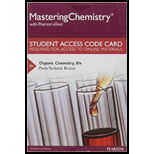
Concept explainers
(a)
Interpretation:
It should be drawn the probable product that would be obtained by the incorrect movement of electron indicated by curved arrows and the wrong in the obtained product’s structure also should be explained.
Concept introduction:
Mechanism of the reaction is the step-by-step description of the process by which reactants are changed into products.
Curved arrows show the bonds that are formed and the bonds that are broken in a reaction.
Curved arrows used to understand a reaction mechanism.
Curved arrows are drawn to show how the electrons move as new covalent bonds are formed existing covalent bonds are broken.
Each arrow represents the simultaneous movement of two electrons from a nucleophile towards an electrophile.
The tail of the arrow is positioned where the electrons are in the reactant; the tail always start at a lone pair of electron or at a bond.
The head of the arrow points to where these same electrons end up in the product; the arrow always points at an atom or a bond.
(b)
Interpretation:
It should be drawn the probable product that would be obtained by the incorrect movement of electron indicated by curved arrows and the wrong in the obtained product’s structure also should be explained.
Concept introduction:
Mechanism of the reaction is the step-by-step description of the process by which reactants are changed into products.
Curved arrows show the bonds that are formed and the bonds that are broken in a reaction.
Curved arrows used to understand a reaction mechanism.
Curved arrows are drawn to show how the electrons move as new covalent bonds are formed existing covalent bonds are broken.
Each arrow represents the simultaneous movement of two electrons from a nucleophile towards an electrophile.
The tail of the arrow is positioned where the electrons are in the reactant; the tail always starts at a lone pair of electron or at a bond.
The head of the arrow points to where these same electrons end up in the product; the arrow always points at an atom or a bond.
(c)
Interpretation:
It should be drawn the probable product that would be obtained by the incorrect movement of electron indicated by curved arrows, and the wrong in the obtained product’s structure also should be explained.
Concept introduction:
Mechanism of the reaction is the step-by-step description of the process by which reactants are changed into products.
Curved arrows show the bonds that are formed and the bonds that are broken in a reaction.
Curved arrows used to understand a reaction mechanism.
Curved arrows are drawn to show how the electrons move as new covalent bonds are formed existing covalent bonds are broken.
Each arrow represents the simultaneous movement of two electrons from a nucleophile towards an electrophile.
The tail of the arrow is positioned where the electrons are in the reactant; the tail always starts at a lone pair of electron or at a bond.
The head of the arrow points to where these same electrons end up in the product; the arrow always points at an atom or a bond.
(d)
Interpretation: It should be drawn the probable product that would be obtained by the incorrect movement of electron indicated by curved arrows. And the wrong in the obtained product’s structure also should be explained.
Concept introduction:
Mechanism of the reaction is the step-by-step description of the process by which reactants are changed into products.
Curved arrows show the bonds that are formed and the bonds that are broken in a reaction.
Curved arrows used to understand a reaction mechanism.
Curved arrows are drawn to show how the electrons move as new covalent bonds are formed existing covalent bonds are broken.
Each arrow represents the simultaneous movement of two electrons from a nucleophile towards an electrophile.
The tail of the arrow is positioned where the electrons are in the reactant; the tail always starts at a lone pair of electron or at a bond.
The head of the arrow points to where these same electrons end up in the product; the arrow always points at an atom or a bond.
Trending nowThis is a popular solution!

Chapter 5 Solutions
Organic Chemistry Study Guide and Solutions Manual, Books a la Carte Edition (8th Edition)
- What is the name of the following compound? SiMe3arrow_forwardK Draw the starting structure that would lead to the major product shown under the provided conditions. Drawing 1. NaNH2 2. PhCH2Br 4 57°F Sunny Q Searcharrow_forward7 Draw the starting alkyl bromide that would produce this alkyne under these conditions. F Drawing 1. NaNH2, A 2. H3O+ £ 4 Temps to rise Tomorrow Q Search H2arrow_forward
 Chemistry for Today: General, Organic, and Bioche...ChemistryISBN:9781305960060Author:Spencer L. Seager, Michael R. Slabaugh, Maren S. HansenPublisher:Cengage Learning
Chemistry for Today: General, Organic, and Bioche...ChemistryISBN:9781305960060Author:Spencer L. Seager, Michael R. Slabaugh, Maren S. HansenPublisher:Cengage Learning Organic ChemistryChemistryISBN:9781305580350Author:William H. Brown, Brent L. Iverson, Eric Anslyn, Christopher S. FootePublisher:Cengage Learning
Organic ChemistryChemistryISBN:9781305580350Author:William H. Brown, Brent L. Iverson, Eric Anslyn, Christopher S. FootePublisher:Cengage Learning

